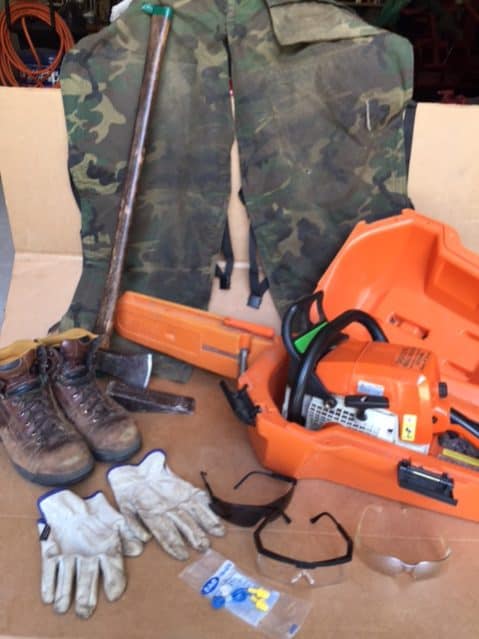I know what you’re thinking; what’s wrong with this guy! The fact is, this is pretty much my normal apparel, for mowing grass, on those hot, dry, sunny summer days. Wearing PPE, short for personal protective equipment, isn’t just limited to using tools and equipment
My grass mowing get-up includes my hat and sunscreen to protect against the sun. If you read my article on skin cancer you’ll see why this is so important to me. I also wear safety glasses, earplugs and a respirator, with particle filter cartridges. It may look like a little overkill, but this really does improve my quality of life!
On those hot, dry days when I mow my grass, there is usually a cloud of dust and pollen, and you just can’t avoid breathing it in. It leaves me gagging, sneezing and hacking the rest of the day. And about 80% of the time I wake up the next morning with a sinus headache and/or congestion. I’ve finally come to the conclusion that this is what I need to do to prevent this misery. I can’t worry about what the neighbors think and besides, I’m not going to win any fashion awards anyways!
This mentality is very important when preparing to take on any DIY home project. Everyone always thinks about do I have the right tools? Do I have the right materials? Do I have enough materials? That’s good! You should ask yourself those questions. It’s thinking ahead and preparing that will give you the best chance of success in any project or repair.
But take it one step further. How can I protect myself every step of the way? When using power tools, a good place to start is reading and following the manufactures instruction. Not only do they tell you how to use their tools, but they tell you how to clean and maintain them, so they will give you years of good, quality service.
You’ll also notice that almost all manufacturers include safety precautions. In today’s world of liability, they need to do this to protect themselves. It’s good for them and it’s also good for the new owner of the tool too.
In this article, we will be providing you with a few links to some products for pricing and informational purposes. We are required to let you know some of these links are “affiliate links”. This means if you click on a link and make a purchase, we could make a small commission, at no extra cost to you. This helps offset the cost of maintaining our website. Now, let’s get started.
Do Small Jobs Require Wearing PPE? Absolutely!!!
Table of Contents
What I’ve witnessed throughout my life is that people are usually pretty good at putting on their PPE when tackling big projects. They put the stuff on for demolition and they wear it while they are doing the bulk of the cutting, grinding, nailing; all the noisy, hazardous stuff, which is great!
However, the majority of folks tend to let their guard down once they get toward the end of the project and they are putting the finishing touches on things.
It’s just a quick little cut, with the saw, here or one more nail, with the nail gun, there and my safety glasses and earmuffs are way over there! Or maybe you have to make a quick fix on something around the house and your PPE isn’t handy. This will only take a second, so it’ll be okay without it this once. Well, the odds may be in your favor for “just this once”, but are you willing to gamble with your eyesight or the accumulative effect of hearing loss? I hope not! Take the time to protect yourself.
Find the Right PPE
Each PPE category comes with such a wide variety of types, styles, and sizes that I’m confident you’ll be able to find something that fits nicely and is comfortable. Most of this stuff isn’t that expensive, so keep multiple sets around and there will always be something readily available. That way you’ll be more apt to use it.

For us, a project isn’t considered successful unless it’s completed and you’re able to enjoy it. That means having all your fingers and toe; no stitches or broken bones and being able to see, hear and admire the finished product. There are thousands of different projects out there, complete with plans and instruction, but none of that matters if you don’t follow the plans, execute it safely and wear your PPE.
Basic PPE Everyone Should Have
Below is a list of the basic PPE that everyone should have. I’ve added links to some of these items that will take you to Amazon, where you can get additional information and pricing. It is also a very convenient way to purchase many of these items too. And as always, I want to fully disclose that if you were to purchase any items when using these links, I may earn a small commission. The commission helps support our website.
Eye Protection
Safety glasses should be used for all jobs, big or small. Safety glasses come in a variety of shapes, sizes, and colors. Some even have magnifiers (affectionately know as cheaters to many), if needed. I even have safety glasses with LED lights attached. They can be purchased with your prescription through your optometrist too. You should add a “face shield” to your collection when using any special cutting or grinding equipment (tile saw, hand grinders, wire brushes, etc…).
Hearing protection
They come in a variety of types and materials. Earmuffs are very popular because you can grab them and put them on even when your hands are a little dirty. Earplugs come in many options. There are foam disposable ones and several types that can be worn around your neck till needed. My favorite is the re-usable 3M earplugs shown below. They fit nicely and can be inserted with dirty hands. The 3M earplugs are also washable and reusable. The key is to find the type that fits you comfortably and use them. Keep plenty around to share with your helpers too!

Reusable Ear Plugs 
Ear Muffs
For all the music and concert enthusiasts, there are concert earplugs specifically made just for you. They are designed to reduce the sound level, yet maintain the quality of the music. The take away here is there is affordable hearing protection for work or noisy hobbies. Do yourself a favor and get several sets and use them.
Respirator/Dust Mask
Dust masks are a must. Use them for sanding wood, mowing, clean out a wood store, or fireplace; anything that creates air-born particulates. Respirators are great too, but be sure you follow the manufactures direction and understand what they are used for. You need special cartridges for vapors and fumes and they do not protect you from oxygen deficiency!!
Gloves
There are so many different types, for so many different uses, that I know I could not possibly list them all. So I’ll list some of the basic types and just say be sure to get a glove that fits properly and try to match them for the task at hand. Here’s my basic list; cotton, cotton with a textured grip, leather, rubber (latex, nitrile, etc…), heat resistant, cut resistant (kevlar). The leather goatskin gloves are my favorites. They are soft, flexible and wear well.
Footwear
As a ruler, just a good pair of shoes that offer good support, cover the entire foot and provide good traction, for the surface you’re working on. NO FLIP-FLOPS OR SANDALS! You’re just asking for trouble. For protection when working with heavy materials (wood or steel), or operating equipment (push mower, string trimmer, chainsaw, etc…) it’s good to wear leather work boots or even a pair with steel toes.
Special PPE Required
Besides wearing standard PPE, there are some tools and equipment that require special protective equipment. Let’s take a look at a couple of examples.
Welding
As you add new hobbies, tools, and equipment the list of required PPE will grow. Welding is a good example of this. The bright arc, flying debris and hot surfaces represent a few of the hazards you’ll need to protect yourself from. A welding helmet, with eye protection, and heavy leather welding gloves are a must. I have written an article on hobby welding that includes safety tips and all the PPE you should consider using. I hope you take the time to read it if you’re thinking of giving welding a try.
Chainsaws
Another tool that should never be used without the proper PPE is a Chainsaw! Along with all the standard items listed above you should always wear a pair of chainsaw chaps to help protect your legs. I personally know someone who was saved from what would have been a terrible injury by his chaps! They really are a must-have.
Another option for folks running chainsaws is a forestry safety helmet. They combine hearing protection, eye and face protection, and the added benefit of head protection. Falling limbs and branches can cause severe injuries. One of the best ways to protect yourself is to read your chainsaw’s owner’s manual. They provide tips on using the saw and point out some of the hazards, such as “kick-back”. The manual typically has lots of good information on safety!

Conclusion
Wearing PPR shouldn’t be considered a burden. It’s there to keep you safe! If you purchase the right style of equipment, that is properly sized, PPE is comfortable to wear. So please wear your PPE and work safely. Make sure you can enjoy your handy work for years to come!
If you have any comments or questions, you can leave them in the comments section below or you can email us at [email protected]. FYI, we do not collect or share email addresses. We will only use them to reply to your comments or provide answers to your questions. We are also required to let you know that some of our links are “affiliate links”. This means if you click on a link and make a purchase, we could make a small commission, at no extra cost to you. This helps offset the cost of maintaining our website. So, if you like what you’ve seen, please be sure to give us a “Like” and “Share” on Facebook and Instagram too. Thank you for reading and good luck with all your home projects!





